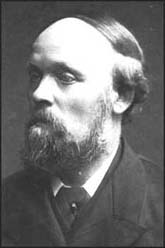George Howell (trade unionist) facts for kids
Quick facts for kids
George Howell
|
|
|---|---|
 |
|
| Born | 5 October 1833 Wrington, England
|
| Died | 17 September 1910 (aged 76) Shepherd's Bush, London, England
|
| Nationality | British |
| Occupation | Trade unionist |
George Howell (born October 5, 1833 – died September 17, 1910) was an English leader for workers' rights. He was also a politician who worked to change laws. He was known as a Lib-Lab politician, meaning he was part of the Liberal Party but also strongly supported working people. He served in the House of Commons, which is a main part of the UK Parliament, from 1885 to 1895.
Contents
George Howell's Early Life
George Howell was born in Wrington, a town in Somerset, England. He was the oldest of eight children. His father was a builder and contractor. George went to a primary school in Bristol until he was twelve years old.
After school, he started working with his father. He worked long hours, often twelve hours a day, as a mortar-boy and then a bricklayer. Even though he worked hard, he spent his Sundays reading. He especially liked books like John Foxe's Book of Martyrs and John Bunyan's The Pilgrim's Progress.
Becoming a Campaigner for Change
George didn't enjoy being a builder. So, he decided to become an apprentice shoemaker. Some of the men he worked with were active chartists. Chartists were people who wanted more rights for ordinary working people, like the right to vote.
These colleagues introduced him to radical newspapers. These newspapers had new and bold ideas about how society should work. Because of this, George joined the Chartist movement in 1848. Other co-workers were Methodists, a type of Christian church. George went to their meetings and later became a lay preacher, someone who gives sermons but isn't a full-time minister. He also joined the local temperance movement, which wanted people to drink less alcohol.
Moving to London and Union Work
In 1854, George Howell moved to London. He couldn't find work as a shoemaker, so he went back to being a bricklayer. In London, he went to many political meetings. He met important thinkers like Karl Marx and Charles Bradlaugh.
In 1859, he joined the Operative Bricklayers' Society. This was a New Model Trade Union, which meant it was very organized. He helped lead the London builders' strike in 1859. The workers were striking to get a nine-hour workday. Because of his union work, employers refused to hire him for five years. This is called being blacklisted.
Leading Workers' Rights Movements
In 1861, George Howell was chosen to be part of the London Trades Council (LTC). He became its secretary. He also joined the fight for universal suffrage. This meant he wanted all men to have the right to vote, not just those who owned property.
He became the full-time secretary of the Reform League in 1865. George organized big protests in London in 1866 and 1867. He played a key role in the campaign that led to the 1867 Reform Act. This law gave more men the right to vote. However, George felt it wasn't enough and kept fighting for everyone to have the right to vote.
In 1871, George Howell became the secretary of the Trades Union Congress (TUC). The TUC is a large group of trade unions in the UK. He also wrote for The Bee-Hive, a journal for trade unionists. He published several books in the 1870s.
Serving in Parliament
George Howell tried to become a Member of Parliament (MP) several times. He ran in 1868 and 1874 for Aylesbury. He also ran in 1881 for Stafford. He finally won a seat in Parliament in 1885. He became the Lib-Lab MP for Bethnal Green North East in London.
In Parliament, George helped pass the Merchant Shipping Act 1894. This law helped improve conditions for sailors. He won his seat again in 1886 and 1892. But in 1895, he lost to Mancherjee Bhownagree from the Conservative Party.
After losing his seat, George Howell's health was not good. He retired from public life. His friends and the TUC collected money to help him. George Howell passed away on September 17, 1910, in Shepherd's Bush, London. He was buried at Nunhead Cemetery.
Notable Books by George Howell
- A Handy Book of Labour Laws (1876)
- 'The History of the International Working Men's Association' (1878)
- Conflicts of Capital and Labour (1878)
- Trade Unionism New and Old (1891)
- Labour Legislation, Labour Movements and Labour Leaders (1902)

